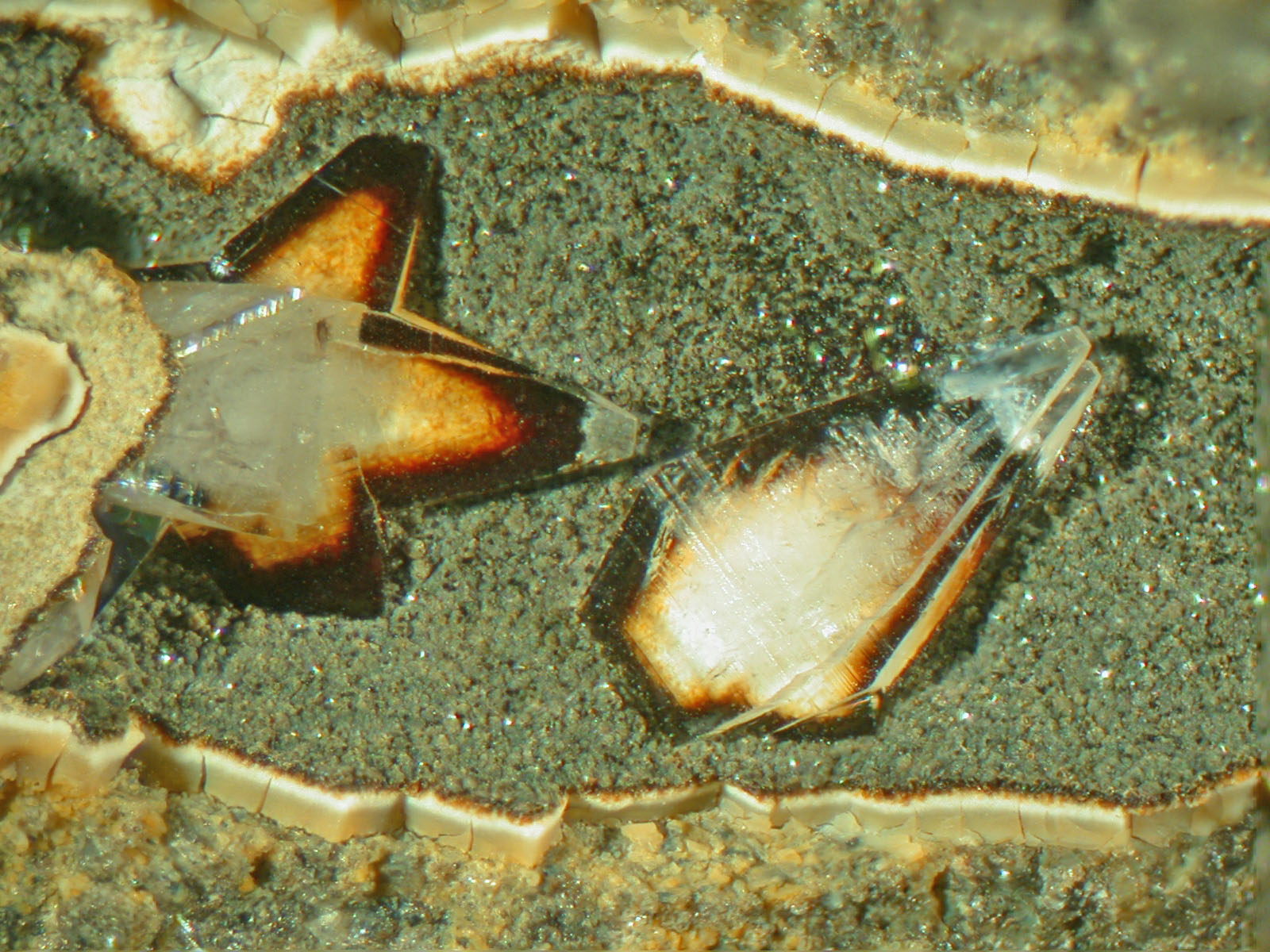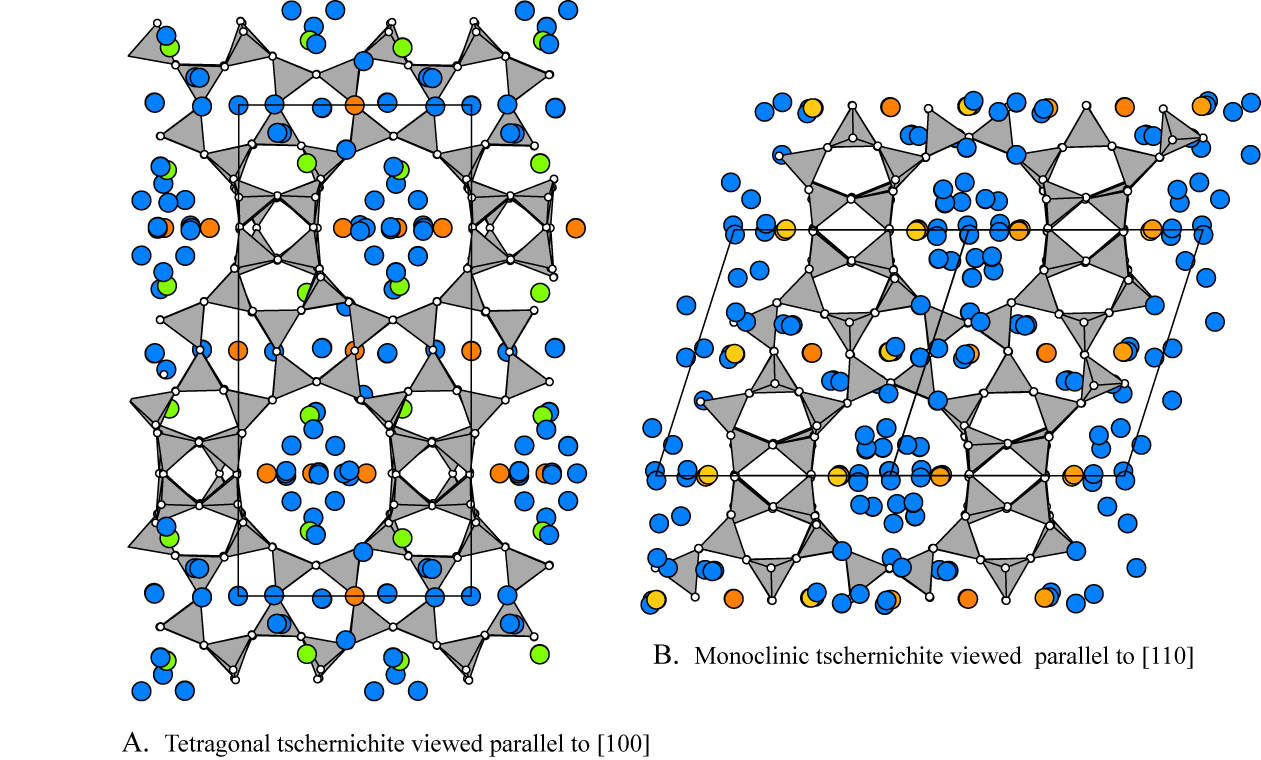| |
|
| Tschernichite |
|(Ca,Mg,Na0.5)( H2O)8 [Al2Si6O16] |
| |
|
|
|
| Habit |
|
 |
| |
Steep dipyramids to 1 cm with slightly curved, striated faces, and a small basal pinacoid with growth hillocks. Also as drusy aggregates. |
| |
| Physical
properties: |
| |
Fracture: Conchoidal
Hardness: 3.5. D = 1.998 gm/cm3.
Luster: vitreous to dull.
Streak: white.
|
| |
Tschernichite, Neer Road Pit, Goble Oregon, USA. Width of view, about 1 cm.
|
| Optical properties: |
|
| |
Color: colorless to white; colorless in thin section.
Uniaxial (-). ω 1.484, ε 1.483, δ 0.001, (2Vα 0° - 35°) |
|
| |
|
| Crystallography: |
|
| |
Unit cell data:
-
Tetragonal polytype (A): a 12.634, c 26.608 Å, Z= 8, Space group P4122
- M
onoclinic polytype (B): a 17.983, b 17.966, c 14.625 Å, β = 114.31°, Z=8, Space group C2/c
(Alberti et al. 2002) |
|
| |
|
| |
|
| |
|
|
|
| Name: |
|
| |
Tschernichite was described and named by Boggs et al. (1993) to honor Rudy W. Tschernich, a zeolite investigator of the Pacific Northwest and discoverer of the mineral. It was shown by Smith et al. (1991) that tschernichite is the natural analogue of synthetic zeolite Beta. The type material comes from a small pit on Neer Road, 0.2 km north of Goble, Columbia County, Oregon, U.S.A. |
| |
|
|
|
| Crystal structure: |
|
| |
The type tschernichite and zeolite Beta crystals are not suitable for single crystal structure analysis, because many X‑ray diffraction reflections are diffuse. Moreover, X‑ray powder diffraction patterns of both materials are a combination of sharp and broad reflections, indicating disorder in the framework. Using transmission electron micrographs and electron diffraction photographs of zeolite Beta, Newsam et al. (1988) postulated three polytypic frameworks (polytype A with the space group P4122 and the enantiomorph P4322; B with space group C2/c; and C with space group P2/c). These suggestions were confirmed by Alberti et al. (2002), who isolated the tetragonal polytype A and the monoclinic polytype B from samples collected at Mt. Adamson, Antarctica, for X-ray diffraction studies (see the accompanying figure). |
| |
 |
| |
Tschernichite and zeolite Beta, like several other recently discovered high-silica zeolites (boggsite, gottardiite, mutinaite, and terranovaite), have a pentasil framework, i.e. characterized by 5-rings. The building units of the framework of polytype A of zeolite Beta are the polyhedra bet (41425252), mtw (425462), and tes (54), all of which contain 5-rings (see BEA ). In polytype A these polyhedra link by face sharing and form columns in both the [100] and [010] directions, and between the columns are 12-ring channels also in the same two directions. The framework of polytype B consists of the same building units in nearly the same structure, but with monoclinic repeat in the [001] direction. Alberti et al. (2002) were able to locate many of the channel cation and H2O positions, shown in the figure (Ca – orange, Mg - green, and H2O – blue). |
| |
|
| Chemical composition: |
| |
Published analyses of tschernichite (Boggs et al. 1993, Galli et al. 1995, and Alberti et al. 2002) show some compositional variation depending on the crystal size. The large tetragonal crystals (several mm sized) have the higher Si content in the framework (TSi = 0.80) and the higher Ca in the channels. The smaller monoclinic crystals (less than 0.5 mm) have framework compositions near TSi = 0.72, and in the channels Ca-dominant is dominant, but larger amounts of Mg. |
| |
|
| Occurrences: |
| |
Tschernichite has been found in only three localities, in vesicles of tholeiitic basalt at Goble, Oregon, USA, in upper Miocene volcanic rocks near Santiago de Puriscal in central Costa Rica (Tschernich and Boyd 1992), and in vesicles of a dolerite sill at Mt. Adamson, North Victoria Land, Antarctica.
Diagenesis or other alteration of basalt
The Goble zeolite locality is a relatively small area of intense zeolitization of basalt of the Eocene Goble Volcanic Series (Boggs et al. 1993). Heulandite, stilbite, thomsonite, and chabazite among many others fill vesicles and fractures in the basalt. Tschernichite was found in one small volume of dense rock near center of a basalt flow. Tschernichite occurs as single crystals or clusters of twinned crystals and as drusy linings of cavities with hemispheres of boggsite. Zeolitization of the Goble area is interpreted as hydrothermal, because the alteration zone seems to be vertical, possibly along a fault, now eroded by Goble Creek. However, the groundmass of the host rock does not show pervasive alteration, as is the case of hydrothermally altered basalt. Instead the vertical cracks related to the fault may have allowed access of warm water to dense basalt allowing alteration but with low rock to fluid ratio.
In Antarctica tschernichite occurs in vesicles and veinlets in the Jurassic Ferrar dolerite sill exposed on the flanks of Mt. Adamson, Northern Victoria Land, Antarctica. It occurs as crystals, twinned crystals, or drusy cavity lining, and is rarely with other zeolites in the same cavity, although boggsite is commonly in same rock (Galli et al. 1995). |
| |
|
| References: |
| |
Alberti A, Cruciani G, Galli E, Merlino S, Millini R, Quartieri S, Vezzalini G, and Zanardi S. 2002. Crystal structure of tetragonal and monoclinic polytypes of tschernichite, the natural counterpart of synthetic zeolite beta. Jour. Phys. Chem,, B106, 10277-10284.
Boggs, R.C., Howard, D.G., Smith, J.V., and Klein, G.L. 1993. Tschernichite, a new zeolite from Goble, Columbia County, Washington. Am. Mineral. 78, 822-826.
Galli, E., Quartieri, S., Vezzalini, G. and Alberti, A. 1995. Boggsite and tschernichite-type zeolites from Mt. Adamson, Northern Victoria Land (Antarctica). Eur. J. Mineral. 7, 1029-1032.
Smith, J.V., Pluth, J.J., Boggs, R.C. and Howard, D.G. 1991. Tschernichite, the mineral analogue of zeolite beta. Jour. Chem. Soc., Chem. Comm. 363-364.
Newsam, J.M., Treacy, M.M., Koetsier, W.T., and de Gruyter, C.B. 1988. Structural characterization of zeolite beta. Proc. Roy. Soc. London, A 420, 375-405. |

